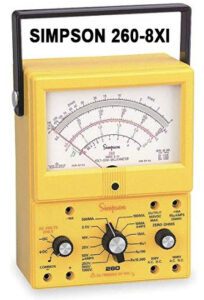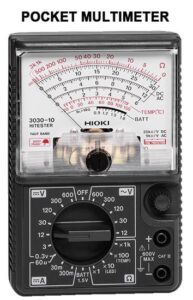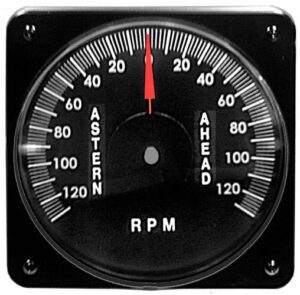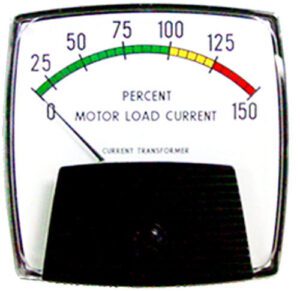The Simpson 260 has been an industry-standard multimeter for over 70 years. It is now available in 13 versions including industrial, ruggedized, safety rated, and high accuracy models. Why is this analog product still used, despite the abundance of digital multimeters? More generally, what advantages does an analog meter have compared to its digital counterpart?
 Analog Multimeter Advantages
Analog Multimeter Advantages
An analog multimeter is easy to use. Select the correct input terminals, then turn the dials to the desired function/range position. Once selected, this setting is fixed and visible at all times, even when the meter is not connected. A digital multimeter (DMM) is also easy to use. However, range and function may only be visible during the test. Some DMMs can change the function or range setting (auto-range, auto-function), which may lead to erroneous results.
The needle position gives a quick indication of signal magnitude, relative to the meter’s full-scale setting. With an analog multimeter there is no waiting for the meter to auto-range or the digital display to settle to a readable value. While not as precise as a DMM readout, the analog resolution is sufficient for many test situations.
Unlike a DMM, voltage and current measurements can be made regardless of battery condition. The analog multimeter doesn’t use a battery, except for the ohms function. A dead battery makes the DMM totally inoperative.
Noisy signals are easier to read with an analog meter. A small needle oscillation can be quickly averaged by the eye. Bouncing digits on a DMM are difficult to read and might be impossible to interpret.
 Test and calibration procedures for older equipment are often written around the input impedance and signal conditioning characteristics of an analog multimeter. Substituting a DMM requires different meter settings and may give different results.
Test and calibration procedures for older equipment are often written around the input impedance and signal conditioning characteristics of an analog multimeter. Substituting a DMM requires different meter settings and may give different results.
The analog multimeter gives fewer ‘ghost’ readings than a digital meter. Due to its higher input impedance, the DMM sometimes displays noise that can be misinterpreted as a valid reading.
The analog format provides a rapid indication of continuity or an on-scale reading. The needle ‘twitch’ is all the user needs to see. The DMM display responds more slowly. Its continuity beeper may be impossible to hear in a noisy environment or the circuit resistance may be too high to activate the beeper.
The analog meter emits zero RFI. It has no internal clocks or oscillators to disturb sensitive test circuits. Susceptibility to EMI is also low.
Over the years, DMM manufacturers added features to their meters to address some of these analog advantages. They’ve also included other functions to make their models more attractive to users. Despite these efforts, the analog multimeter continues to have a place in many service tool kits.
Analog Panel Meter Advantages
Many of the analog multimeter advantages described here also apply to analog panel meters. Analog panel meters are easy to install. Most models have only two terminals to connect. There are no configuration settings or setup menus to complicate the installation.
Analog voltmeters and ammeters do not require external power. Lack of available power is a major issue when attempting to replace an analog meter with a digital meter in an existing panel. Analog meters will continue to indicate, even when the power supply to the digital meters in the panel is turned off or fails. This can alert users to the presence of hazardous voltages or high current flows in equipment thought to be shut down.
 The analog format is easy to read. The meter dial always shows function and range, even when not in use. The dial can be customized to display scaled values and special signal labels. Meter sizes up to 6 or 8 inches can be specified to provide visibility at a distance. Center zero analog meters give a clearer indication of signal polarity than the presence of a small minus sign in the digital display.
The analog format is easy to read. The meter dial always shows function and range, even when not in use. The dial can be customized to display scaled values and special signal labels. Meter sizes up to 6 or 8 inches can be specified to provide visibility at a distance. Center zero analog meters give a clearer indication of signal polarity than the presence of a small minus sign in the digital display.
 A major analog advantage is the rapid visual indication of signal level. The meter face can also include color zones to define normal or dangerous operating levels. Using these guides, operators can quickly determine whether a process is within normal parameters.
A major analog advantage is the rapid visual indication of signal level. The meter face can also include color zones to define normal or dangerous operating levels. Using these guides, operators can quickly determine whether a process is within normal parameters.
Many processes that use analog panel meters have procedures and historical data based on those meters. Changing to digital would require revised procedures and new reference data.
The noisy signal and EMI/RFI benefits of analog panel meters are similar to those found in analog multimeters.
While viewed by many as specialty or niche products, analog panel meters still provide a simple and effective display of signal parameters in many applications.
Weschler is North America’s largest distributor of analog and digital panel meters. Whether your application is best served by a Weschler product or one of the many products we distribute, we are happy to work with you to solve your measurement and control needs.
